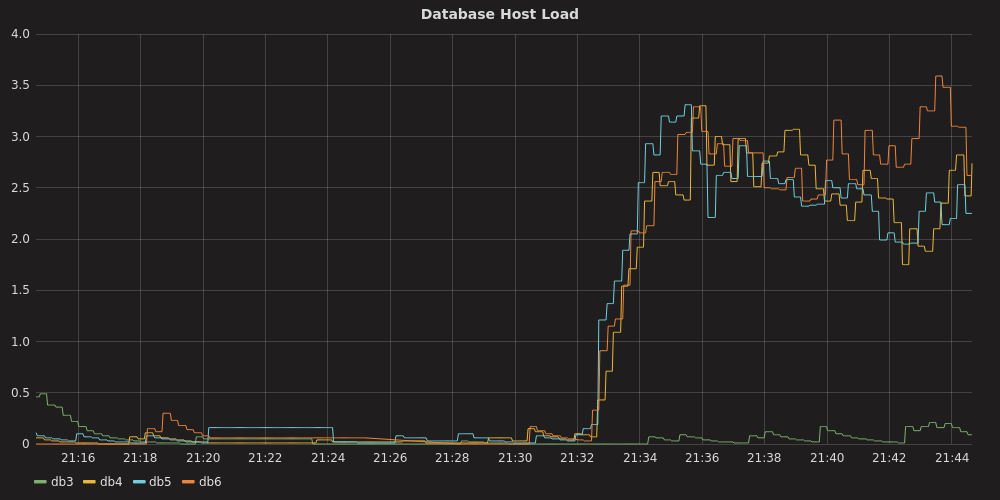Database Load Balancing
Distribute read-only queries among multiple database servers.
Overview
Database load balancing improves the distribution of database workloads across multiple computing resources. Load balancing aims to optimize resource use, maximize throughput, minimize response time, and avoid overload of any single resource. Using multiple components with load balancing instead of a single component may increase reliability and availability through redundancy. Wikipedia article
When database load balancing is enabled in GitLab, the load is balanced using a simple round-robin algorithm, without any external dependencies such as Redis. Load balancing is not enabled for Sidekiq as this would lead to consistency problems, and Sidekiq mostly performs writes anyway.
In the following image, you can see the load is balanced rather evenly among
all the secondaries (db4, db5, db6). Because SELECT queries are not
sent to the primary (unless necessary), the primary (db3) hardly has any load.
Requirements
For load balancing to work you will need at least PostgreSQL 9.2 or newer, MySQL is not supported. You also need to make sure that you have at least 1 secondary in hot standby mode.
Load balancing also requires that the configured hosts always point to the primary, even after a database failover. Furthermore, the additional hosts to balance load among must always point to secondary databases. This means that you should put a load balance in front of every database, and have GitLab connect to those load balancers.
For example, say you have a primary (db1.gitlab.com) and two secondaries,
db2.gitlab.com and db3.gitlab.com. For this setup you will need to have 3
load balancers, one for every host. For example:
-
primary.gitlab.comforwards todb1.gitlab.com -
secondary1.gitlab.comforwards todb2.gitlab.com -
secondary2.gitlab.comforwards todb3.gitlab.com
Now let's say that a failover happens and db2 becomes the new primary. This means forwarding should now happen as follows:
-
primary.gitlab.comforwards todb2.gitlab.com -
secondary1.gitlab.comforwards todb1.gitlab.com -
secondary2.gitlab.comforwards todb3.gitlab.com
GitLab does not take care of this for you, so you will need to do so yourself.
Finally, load balancing requires that GitLab can connect to all hosts using the same credentials and port as configured in the Enabling load balancing section. Using different ports or credentials for different hosts is not supported.
Use cases
- For GitLab instances with thousands of users and high traffic, you can use database load balancing to reduce the load on the primary database and increase responsiveness, thus resulting in faster page load inside GitLab.
Enabling load balancing
For the environment in which you want to use load balancing, you'll need to add
the following. This will balance the load between host1.example.com and
host2.example.com.
In Omnibus installations:
-
Edit
/etc/gitlab/gitlab.rband add the following line:gitlab_rails['db_load_balancing'] = { 'hosts' => ['host1.example.com', 'host2.example.com'] } Save the file and reconfigure GitLab for the changes to take effect.
In installations from source:
-
Edit
/home/git/gitlab/config/database.ymland add or amend the following lines:production: username: gitlab database: gitlab encoding: unicode load_balancing: hosts: - host1.example.com - host2.example.com Save the file and restart GitLab for the changes to take effect.
Balancing queries
Read-only SELECT queries will be balanced among all the secondary hosts.
Everything else (including transactions) will be executed on the primary.
Queries such as SELECT ... FOR UPDATE are also executed on the primary.
Prepared statements
Prepared statements don't work well with load balancing and are disabled automatically when load balancing is enabled. This should have no impact on response timings.
Primary sticking
After a write has been performed, GitLab will stick to using the primary for a certain period of time, scoped to the user that performed the write. GitLab will revert back to using secondaries when they have either caught up, or after 30 seconds.
Failover handling
In the event of a failover or an unresponsive database, the load balancer will try to use the next available host. If no secondaries are available the operation is performed on the primary instead.
In the event of a connection error being produced when writing data, the operation will be retried up to 3 times using an exponential back-off.
When using load balancing, you should be able to safely restart a database server without it immediately leading to errors being presented to the users.
Logging
The load balancer logs various messages, such as:
- When a host is marked as offline
- When a host comes back online
- When all secondaries are offline
Each log message contains the tag [DB-LB] to make searching/filtering of such
log entries easier. For example:
[DB-LB] Host 10.123.2.5 came back online
[DB-LB] Marking host 10.123.2.7 as offline
[DB-LB] Marking host 10.123.2.7 as offline
[DB-LB] Marking host 10.123.2.7 as offline
[DB-LB] Marking host 10.123.2.7 as offline
[DB-LB] Marking host 10.123.2.7 as offline
[DB-LB] Host 10.123.2.6 came back online
[DB-LB] Marking host 10.123.2.7 as offline
[DB-LB] Marking host 10.123.2.7 as offline
[DB-LB] Marking host 10.123.2.7 as offline
[DB-LB] Host 10.123.2.7 came back online
[DB-LB] Host 10.123.2.7 came back online